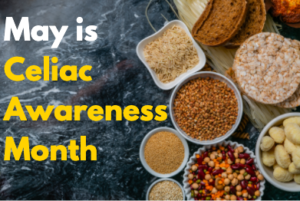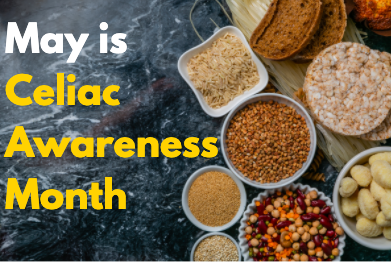Celiac Awareness Month is Here
 You have likely heard of a gluten-free diet, but you may not be aware of why some people must follow one. Gluten is a protein that when ingested can trigger painful symptoms in a person with celiac disease. Throughout the month of May, the healthcare community aims to inform as many people about this disease for Celiac Awareness Month.
You have likely heard of a gluten-free diet, but you may not be aware of why some people must follow one. Gluten is a protein that when ingested can trigger painful symptoms in a person with celiac disease. Throughout the month of May, the healthcare community aims to inform as many people about this disease for Celiac Awareness Month.
Celiac disease is a genetic disease that affects the small intestines and interferes with the absorption of nutrients. When gluten is eaten by someone who has celiac disease, an autoimmune response is triggered, which causes damage to the small intestine. This damage impedes the small intestine from absorbing nutrients which can lead to malnutrition among other problems. There is currently no cure for Celiac disease, but symptoms can be eased by eliminating gluten from the diet.
Gluten is found in wheat, barley, and rye. However, with advancements in food science, many foods, such as bread, have a gluten-free alternative. If you are a home baker, you can purchase flour that does not contain any gluten. Those with celiac disease no longer have to miss out on the foods they once enjoyed.
Signs and Symptoms of Celiac
When a person with celiac disease eats gluten there is damage caused to the small intestine that can lead to more digestive problems. A person with celiac disease will often experience painful symptoms after eating gluten due to this autoimmune reaction. Here is a list of signs and symptoms you can look out for in yourself or a loved one who may have celiac disease:
- Bloating and stomach pain after eating gluten-containing foods
- Unexplained weight loss
- Arthritis
- Frequent and unexplained migraines
These symptoms alone don’t mean you have celiac disease, you may just have a gluten intolerance or a different health issue. Monitor how you feel after eating gluten and if symptoms persist, see your physician.
The Truth About Gluten
As awareness for celiac disease has spread, so has the adaption of a gluten-free diet in the general public. Many restaurants and food products have gluten-free on menus and labels. An important thing to keep in mind is that if you do not have a gluten intolerance or celiac disease, gluten is not bad for you.
A gluten-free diet was meant for those with celiac disease to give symptom relief and was not meant to become the next diet craze. A person with no underlying health issues should not be eliminating food groups from their diet.
Gluten-Free Flour Alternatives
However, if you do have celiac disease or gluten sensitivity there are some alternative flours you can use for baking and cooking. No longer do you need to restrict the foods that you love.
Here are just some of the flours available to you:
- Almond Flour
- Buckwheat Flour
- Brown Rice Flour
- Amaranth Flour
- Oat Flour
- Black Bean Flour
- Coconut Flour
- Corn Flour
- Millet Flour
- Quinoa Flour
During this Celiac Awareness Month keep in mind the signs and symptoms and consider your own risk. Also, remember to spread awareness to your loved ones and encourage them to get tested if they have signs and symptoms. It’s key to detect celiac early on to prevent too much damage to the small intestine.
Your Turn to Take Action: Now that you know about the signs and symptoms of celiac disease what steps will you take? Let me know in the comments below.


Leave a Reply
Want to join the discussion?Feel free to contribute!